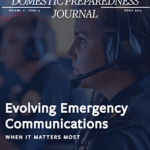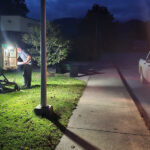- Articles, CBRNE, Fire, Hazmat, Law Enforcement, Military, Public Health, Science & Technology, Terrorism
- Richard Schoeberl and Anthony (Tony) Mottola
According to a recent United Nations Security Council report, the number of Islamic State (IS) attacks is down over the past year. However, there is still no doubt that the IS remains a threat – both globally and domestically – particularly as it transforms into a more covert terrorist organization. Domestically, the IS remains a concern for law enforcement agencies. However, the threats have evolved from groups to individuals – radicalized from the array of propaganda and plethora of ideologies found on the internet.
This evolution of threats has forced law enforcement agencies (LEA) to transform their policing techniques. For the past quarter of a century – with the ever-changing landscape of transnational crime and, more specifically, terrorism – agencies have adapted to meet these conditions. In the early 1990s, the New York Police Department (NYPD) developed Comp Stat to combat crime through computer statistics. With the emergence of international terrorism on U.S. soil, LEAs had to shift tactics and train officers to the global threat, followed by development of the domestic threat from those seeking self-radicalization. In addition to the looming threat from abroad, more recently, left and right wing extremists have taken front stage with an ideology in terrorist tactics and civil unrest, similar to those of foreign terrorist organizations (FTOs). “Today’s terrorist landscape is more fluid and complex than ever,” as cited in the recent White House’s National Strategy for Counterterrorism.
Federal Priorities
Terrorism remains the Federal Bureau of Investigation’s (FBI) number one priority. However, after years of focusing heavily on thwarting attacks from abroad, the shift has gravitated to those of a homegrown nature, with more focus on the homegrown violent extremist. The FBI is currently investigating 5,000 terrorism-related cases globally. Within the United States alone, 1,000 are linked to the IS, while 850 are linked to domestic terrorists. Case in point, The United States has seen a 40% increase in the past year in groups linked to white supremacist extremism. In May 2019, Assistant Director of the FBI’s Counterterrorism Division Michael C. McGarrity advised the House Homeland Security Committee that:
There have been more arrests and deaths caused by domestic terrorists than international terrorists in recent years. We are most concerned about lone offenders, primarily using firearms, as these lone offenders represent the dominant trend for lethal domestic terrorists. Frequently, these individuals act without a clear group affiliation or guidance, making them challenging to identify, investigate, and disrupt.
Reinforcing the FBI’s assessment on the threat of domestic attacks, Brian Murphy, principal deputy undersecretary for intelligence and analysis at the Department of Homeland Security advised the House Committee on Homeland Security that “Lone actors from these movements pose the greatest threat because of their ability to remain undetected by law enforcement.”
Strategic Plan Trends
However, these 2019 revelations are not a new phenomenon to counterterrorism officials. In the FBI Strategic Plan 2004-2009, officials forecasted that domestic terrorism will continue to present a threat to the United States and that new groups posing an increasingly violent threat will emerge. The plan further forecasts the growth in homegrown right-wing extremism, embracing racist sentiment or anti-government ideologies. These groups are forecasted to pose a significant threat because of their propensity for violence. The plan further highlights:
[The] most significant domestic terrorism threat over the next five years will be the lone actor, or lone wolf terrorist. They typically draw ideological inspiration from formal terrorist organizations, but operate on the fringes of those movements. Despite their ad hoc nature and generally limited resources, they can mount high-profile, extremely destructive attacks, and their operational planning is often difficult to detect.
Fast-forward to a 2009 Intelligence Assessment disseminated by the Department of Homeland Security that stated the consequences of an economic downturn, illegal immigration, and the election of the first African American president, has “created a fertile recruiting environment for rightwing extremists and even resulted in confrontations between such groups and government authorities.” The assessment further addresses the “lone wolf” concerns stating:
The possible passage of new restrictions on firearms and the return of military veterans facing significant challenges reintegrating into their communities could lead to the potential emergence of terrorist groups or lone wolf extremists capable of carrying out violent attacks.
The 2015 Law Enforcement Assessment of the Violent Extremist Threat, conducted by the Triangle Center on Terrorism and Homeland Security at Duke University, found that LEAs do not actually consider Islamic extremism to be their greatest threat, but rather consider anti-government extremists to be the greatest threat they are likely to encounter. Of those surveyed by the center, 74% conveyed anti-government extremism as a top concern in their respective areas and only 39% viewed Islamic extremism as a concern within their jurisdictions. The most recent White House’s National Strategy for Counterterrorism acknowledges that, although the United States continues to face threats from abroad, there is a significant rise in domestic terrorism.
Recently, the debate to label far right-wing extremist groups as domestic terrorists have gained significant attention. Several attacks, including protestors in Charlottesville and a synagogue in Pittsburgh, have led to many organizations like the Anti-Defamation League (ADL) to call for these groups to be investigated as domestic terrorists. Whether it is an FTO like IS or a domestic neo-fascism group, police departments must continue to stay informed from their federal counterparts of these groups’ criminal tactics and techniques.
Thinning Resources
Federal agency resources (e.g., those of the Department of Homeland Security and the FBI) are already overextended on a national level, which makes it difficult to offer significant resources to local law enforcement. The FBI currently has 2,000 counterterrorism agents assigned, with only 250 agents focusing on domestic terrorism issues. The United States does not have a domestic terrorism statute; the Justice Department depends on vaguely connected statutes to prosecute domestic terrorism cases. The FBI defines domestic terrorism as, “Perpetrated by individuals and/or groups inspired by or associated with primarily U.S.-based movements that espouse extremist ideologies of a political, religious, social, racial, or environmental nature.” With the lack of domestic federal terrorism laws, though, federal terrorism cases are dropped to state level terrorism charges. Currently, there are 34 U.S. states and the District of Columbia with varying anti-terrorism laws for prosecution.
The threat of terrorism on U.S. soil continues to loom with the recent arrests of four suspected IS members in Nicaragua. It is believed the four men’s destination was the U.S. border for illegal entry. It is conceivable that they would have enlisted members of Mexican cartels to assist them in crossing the U.S. border. Cartel members that control the drug running and human trafficking on the border are known as gatekeepers. Gatekeepers control every aspect of the border area for the Transnational Criminal Organizations (TCOs). These gatekeepers and TCOs have long been suspected of aiding “special interest aliens” or terrorist watch list individuals to enter the United States as part of their human smuggling activities. TCOs’ criminal and terrorist transgressions have led to a proposal to change their designation from TCO to FTO.
In 2011, U.S. border agents found a cache of weapons, including a rocket launcher, assault rifles, and explosives near the Texas Rio Grande. TCOs have long used terrorist tactics to protect their narcotic and human smuggling operations. U.S. Congress Representatives Mark Green (Tennessee) and Chip Roy (Texas) introduced a proposal to the State Department to designate Mexican cartels as FTOs. President Donald Trump is “very seriously” considering the proposal to hinder the cartels’ hold on border operations. This could have a significant impact on law enforcement policing policies throughout the nation.
There are approximately 200 sanctuary jurisdictions in the United States that limit LEAs from policing the public. Officers cannot report on illegal immigrants involved in criminal activity, which can include nationally recognized gangs or transnational gangs like the Mexican cartels. This can be a concerning issue for law enforcement officers who are attempting to identify subjects charged with a crime. Many illegals involved in criminal activity carry fake identification with fictious names or claim to be juveniles to avoid adult prosecution. Details, like identifying subjects, are often overlooked by lawmakers in jurisdictions, which leave the onus on the officers while processing arrests. The ability for law enforcement officers to confer with U.S. Immigration and Customs Enforcement (ICE) can be a valuable resource in deterring recidivism, illegal reentries, or visa overstays. It may be a federal issue dealing with illegal aliens, but it is the patrol officer’s job to accurately identify subjects for crime victims and courts.
Local Actions for an International Threat
In a recent interview with the author and retired Texas Department of Public Safety Captain Jaeson Jones, who spent 20 years investigating Mexican cartels, he stated:
The cartels are involved in many of the crimes listed in the “Uniform Crime Report” (UCR), but also transnational crimes like kidnapping, indentured servitude, human trafficking, human smuggling, sex trafficking, public corruption, drug trafficking, gun trafficking and money laundering; none of which are reported on the UCR.
Jones further added that designating the cartels as terrorist organizations:
- Limits the mobility of the cartels domestically and internationally;
- Provides authority to the Department of Defense to work with host nation’s military; and
- Allows the Department of Justice and the U.S. Department of the Treasury to investigate the group’s criminal and monetary network.
In 2018, Mexican cartels were linked to the murders of more than 100 politicians to sway Mexico’s elections from a political plateau of fighting organized crime and gang warfare. This will have a direct effect on the law enforcement officers who protect the U.S. public. These officers must be trained to identify the cartels through human trafficking, sex trafficking, and narcotics that are crossing U.S. borders. As members working for cartels head to the cities, suburbs, and rural neighborhoods, officers must have the ability to also identify traits (e.g., tattoos, hand signs, narcotics connections) linked to the cartels in the law enforcement officers’ jurisdictions.
Domestic terrorism threats pose a unique challenge for law enforcement agencies chiefly due to a variety of existing motivational factors, the propensity for potential violence, and the varying methods of undetected attacks. The laser focus on Islamic international terrorism groups over the past several years has allowed domestic terrorism organizations to gain prominence and attract new members, thus complicating this evolving threat. It is a daunting task, though not impossible, for any agency to modify its policing styles for the changing threat of domestic terrorism. The NYPD has repeatedly proven this, especially since the 9/11 attacks. The NYPD established a counterterrorism unit, rebuilt its Intelligence Division, and embedded officers within overseas law enforcement agencies to identify and police international terrorism.
Police departments across the nation developed a network of information sharing that was unprecedented. The same must be done for cartels as they teeter on becoming FTOs and for far-right extremists as the call to investigate them as domestic terrorists increases. The collaboration of federal, state, and local law enforcement agencies can bring about change to policing domestic terrorists’ organizations. Agencies liaising and sharing intelligence will help to curtail the growing threat of cartels, left- and right-wing extremists, and self-radicalizing entities. If federal and state lawmakers use the same tenacity to fight the changing domestic terrorist threat of cartels and extremists, the environment will become safer for the United States.

Richard Schoeberl
Richard Schoeberl, Ph.D., has over 30 years of law enforcement experience, including the Federal Bureau of Investigation (FBI) and the National Counterterrorism Center (NCTC). He has served in a variety of positions throughout his career, ranging from a supervisory special agent at the FBI’s headquarters in Washington, D.C., to unit chief of the International Terrorism Operations Section at the NCTC’s headquarters in Langley, Virginia. Before these organizations, he worked as a special agent investigating violent crime, human trafficking, international terrorism, and organized crime. Additionally, he has authored numerous scholarly articles, serves as a peer mentor with the Police Executive Research Forum, is currently the chair of the criminal justice and homeland security graduate and undergraduate programs at the University of Tennessee Southern, and works with Hope for Justice—a global nonprofit combating human trafficking. He has served as an advisor withDomestic Preparedness Journalfor two decades.
- Richard Schoeberlhttps://domesticpreparedness.com/author/richard-schoeberl
- Richard Schoeberlhttps://domesticpreparedness.com/author/richard-schoeberl
- Richard Schoeberlhttps://domesticpreparedness.com/author/richard-schoeberl
- Richard Schoeberlhttps://domesticpreparedness.com/author/richard-schoeberl

Anthony (Tony) Mottola
Anthony (Tony) Mottola, Ph.D., has over 35 years of law enforcement and security experience, including the New York City Police Department, United States Air Force, and the National Basketball Association. He retired as a sergeant detective after 25 years as a member of the New York Police Department (NYPD). He served as executive officer for the NYPD Intelligence Bureau’s Strategic Unit, which is a covert counterterrorism initiative, and director of the Domestic Liaison Program. He represented the Intelligence Bureau in numerous investigations, including the Boston Bombing, civil unrest, mass shootings, and large-scale incidents outside New York City. During his tenure with NYPD, he worked additional assignments in Counterterrorism, Gang Intelligence, Detective Bureau, Task Force, Street Narcotics Enforcement Unit, anti-gang/graffiti units, and patrol. He was a first responder/search leader for recovery efforts and supervisor of security details in the immediate aftermath of the World Trade Center attacks. He is currently an assistant professor of criminal justice and homeland security at the University of Tennessee Southern.
- Anthony (Tony) Mottolahttps://domesticpreparedness.com/author/anthony-tony-mottola
- Anthony (Tony) Mottolahttps://domesticpreparedness.com/author/anthony-tony-mottola
- Anthony (Tony) Mottolahttps://domesticpreparedness.com/author/anthony-tony-mottola
- Anthony (Tony) Mottolahttps://domesticpreparedness.com/author/anthony-tony-mottola






